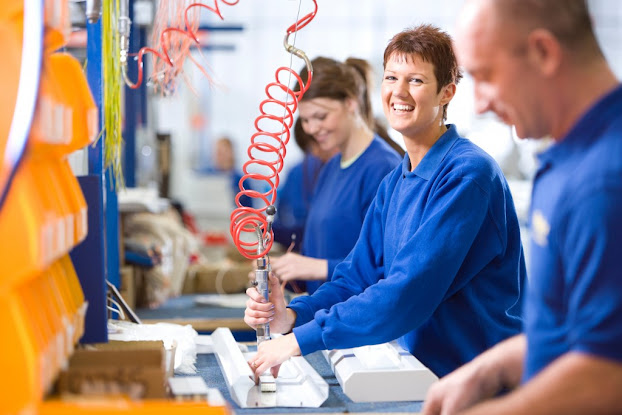- Apply
industrial self-leveling epoxy paint to the floors for improved durability
and safety.
- Use
ergonomic workstations and equipment to reduce the risk of injury and
strain.
- You
should utilize lean manufacturing practices to streamline your operations
and reduce costs.
- You should implement robust safety programs with regular training, clear protocols, and regular inspections.
Optimizing your manufacturing plant's work areas is
essential for maximum productivity and efficiency. You can streamline your
operations and boost your bottom line with the right tools and techniques.
In this blog, you will learn essential tips for optimizing your manufacturing plant's work areas to help you succeed. So whether you're a business owner, manager, or just starting out in your career, read on to learn how to optimize your manufacturing plant and take your business to new heights.
Apply Industrial Self-Leveling Epoxy Paint to the Floors.
One of the best ways to optimize your manufacturing plant's
work areas is to apply industrial self-leveling epoxy paint to the
floors. This type of flooring is highly durable and resistant to chemical
spills, stains, and scratches.
Moreover, it is non-slip, making it safer for your employees
to move around the work area. Industrial self-leveling epoxy paint is also easy
to clean and maintain, reducing your maintenance costs and downtime. By
investing in this type of flooring, you can create a cleaner, safer work
environment that will boost your employees' morale and productivity.
Use Ergonomic Workstations and Equipment.
Another way to optimize your manufacturing plant's work
areas is to use ergonomic workstations and equipment. These types of
workstations and equipment are designed to reduce the risk of injury and strain
on your employees' bodies. For example, you can use adjustable-height
workstations to accommodate employees of different heights and improve their
posture.
You can also use ergonomic equipment such as lift tables,
conveyors, and pallet jacks to reduce the risk of back and shoulder injuries. By
providing your employees with ergonomic workstations and equipment, you can
improve their comfort and productivity, which can result in higher-quality
products and faster turnaround times.
Implement Lean Manufacturing Practices.
Lean manufacturing practices are a set of principles and
tools that can help you streamline your operations and eliminate wasteful
practices. The key principles of lean manufacturing include identifying and
eliminating waste, improving flow, and continuously improving your processes.
By implementing lean manufacturing practices, you can reduce your lead times,
improve your quality, and lower your costs.
For example, you can use visual management tools to track
your inventory levels, reduce overproduction, and avoid stockouts. You can also
use value stream mapping to identify areas of
waste in your processes and eliminate them. By embracing lean manufacturing
practices, you can optimize your manufacturing plant's work areas and achieve
greater efficiency.
Implement Robust Safety Programs.
Finally, implementing robust safety programs is essential
for optimizing your manufacturing plant's work areas. A safe work environment
can reduce the risk of injuries and accidents, which can improve your
employees' morale and productivity. Moreover, it can reduce your liability and
insurance costs, which can save you money in the long run. Here are the steps
you need to take to implement a robust safety program:
Conduct regular safety training sessions.
Conducting regular safety training sessions for your
employees is essential for creating a safe work environment. During these
sessions, you can help your employees understand the risks associated with
their job and teach them how to stay safe. You should also review relevant
safety regulations, such as lockout/tagout procedures and chemical hazard
communication standards.
Create clear safety protocols.
Creating clear safety protocols is also crucial for
optimizing your manufacturing plant's work areas. These protocols should
include specific procedures for handling hazardous materials,
using machinery, and addressing emergency situations. Your safety protocols
should also outline the roles and responsibilities of your employees and
supervisors when it comes to safety.
Regularly inspect the work area.
You should regularly inspect your manufacturing plant's work
areas to identify potential hazards and take corrective action. During these
inspections, you should look for signs of wear and tear on equipment, evidence
of improper storage practices, and any other potential safety risks. You can
use a checklist to make sure all areas are inspected thoroughly.
Invest in the right tools.
Finally, investing in the right tools is essential for
optimizing your manufacturing plant's work areas. The right tools and equipment
can help you reduce maintenance costs, improve your employees' efficiency, and
increase their safety. For example, you can use special lifting devices to move
heavy objects safely or protective gear such as goggles and gloves to protect
against hazardous materials.
By implementing robust safety programs, you can create a
safer, healthier work environment that benefits your employees and business.
Optimizing your manufacturing plant's work areas is
essential for maximum productivity and efficiency.
By applying industrial self-leveling epoxy paint to the
floors, using ergonomic workstations and equipment, implementing lean
manufacturing practices, creating robust safety programs, and investing in the
right tools, you can create a safer and more efficient workplace.
With these tips in mind, you'll be well on your way to developing an optimized manufacturing plant that boosts productivity while keeping costs low.









No comments:
Post a Comment